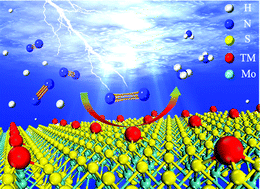A DFT screening of single transition atoms supported on MoS2 as highly efficient electrocatalysts for the nitrogen reduction reaction†
Abstract
The development of low-cost and highly efficient materials for the electrocatalytic nitrogen reduction reaction (NRR) under ambient conditions is an attractive and challenging topic in chemistry. In this study, the electrocatalytic performance of a series of transition metal (TM) atoms supported on MoS2 nanosheets (TM@MoS2) was systematically investigated using density functional theory (DFT) calculations. It was found that Re supported on MoS2 (Re@MoS2) has the best NRR catalytic activity with a limiting potential of −0.43 V, along with high selectivity over the competing hydrogen evolution reaction (HER). Moreover, the ab initio molecular dynamics (AIMD) simulations at 500 K and density of states (DOS) calculations indicated the high thermodynamic stability and excellent electrical conductivity of Re@MoS2. A linear trend between several parameters of single atom catalysts (SACs) and the adsorption Gibbs free energy change of the NH species (ΔG*NH) was observed, indicating the later as a simple descriptor for the facilitated screening of novel SACs. These results pave the way for exploring novel, highly efficient electrocatalysts for the electrochemical NRR under ambient conditions.



 Please wait while we load your content...
Please wait while we load your content...